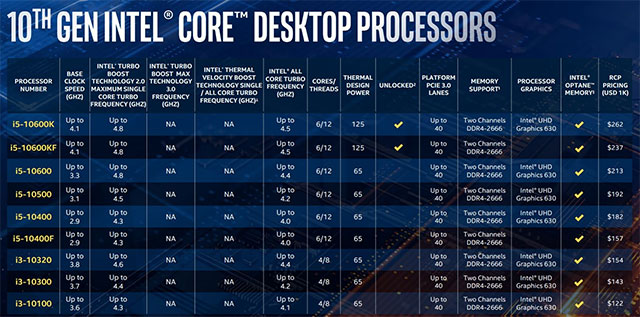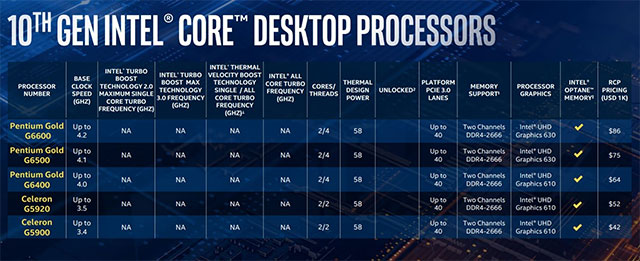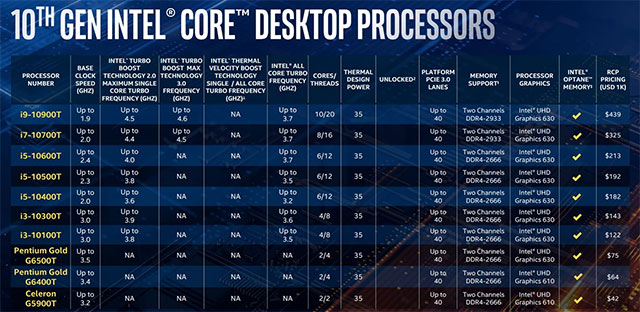10 Gen Intel 10-core desktop CPU, 20 threads, 5.3 GHz and hyper-threading, but still on 14nm ++ process
Intel has just announced its new generation of 10-generation desktop CPUs with some notable improvements. This CPU series is a branch of Comet Lake S, which means they are all built on the same familiar 14nm ++ process, but will use LGA1200 new generation socket. Overall with this new CPU series, Intel will still mainly focus on performance instead of energy saving.
These 10th Gen Intel Core desktop CPU models will still support DDR4 and PCIe 3.0 RAM and UHD 630 integrated GPU. The difference from the previous generations will mainly come from the boost clock algorithm.
At the top of the table will be 2 Core i9-10900K and Core i9-10900KF chips. In it, the letter 'K' indicates that the CPU has been unlocked and 'F' indicates there is no integrated graphics card (iGPU). These are the first two GPU models to have Intel's 10-core, 20-thread and Thermal Velocity Boost, which allows clock speeds up to 5.3GHz. According to Intel's advertisement, these are the most powerful gaming chips on the market at the moment, with the price range from 422 USD to 488 USD.
 8th Gen Intel Core i9
8th Gen Intel Core i9 Another thing worth noting is that all 10-generation K series CPUs have a TDP of 125W, while the previous generation CPUs have almost a TDP of no more than 95W, and even ordinary CPUs are still 65W. While the new Core i9 series is increased from 8 to 10 cores, Core i7 still owns 8 cores.
However, the notable highlight lies in the "re-export" of hyperthreading (Hyperthreading) on all Intel Core desktop chips, including Core i5, Core i3 and Pentium Gold, promising to bring processing capabilities. Multithreading task management is significantly improved compared to its predecessors.
Speaking of low-end CPUs, both Pentium Gold and Celeron still have dual cores, but have hyperthreading support. In addition, the base clock has been raised to 3.5GHz, 3.4GHz and 3.2GHz, respectively - the numbers are not bad for chips that cost less than $ 100.
Some notable features on Intel's 10th generation desktop CPUs include DDR4-2933 memory support, Intel Ethernet Connection I225 2.5G and built-in Wi-Fi 6 AX201. Intel said that compared to the previous generation, Comet Lake S provides 18% faster 4K video editing, and the FPS level is significantly improved on some tested games: An additional 10% FPS for PUBG, 13% FPS on Monster Hunter and over 33% FPS for Mount & Blade II: Bannerlord.
The 10th generation Intel Core CPU line is officially available around the end of May, with the K series coming first.
Regarding specific parameters and prices, please refer to the information in the image below:
You should read it
- Learn about E-Core and P-Core in Intel CPUs
- Should I choose Intel Core i9, Core i7 or Core i5 CPU?
- Intel launches 10th-generation Core X-series processors, the most powerful model with 18 cores priced under $ 1,000
- What is Intel's new Core i9 CPU line?
- Information about the new generation Intel Core i3 / i5 / i7 mobile processors
- Does your computer need Intel Core i3, i5 or i7?
- What is Intel Core i5 1135g7? Detailed parameters and performance
- 6 reasons to avoid Intel's 14th generation CPU
May be interested
- Intel's 9th generation microprocessor can be released on October 1
 as planned, intel's 10nm cannon lake chip will be postponed until 2019, but this year's version will have improvements on the current 14nm process, resulting in more cores and faster clock speeds.
as planned, intel's 10nm cannon lake chip will be postponed until 2019, but this year's version will have improvements on the current 14nm process, resulting in more cores and faster clock speeds. - Intel unveiled 10th generation Core i: codenamed Comet Lake-S, still 14nm but has hit the 10 core 20 thread on the popular PC line
 the most successful mainstream cpu in intel's history, core i has just been released the 10th generation codename comet lake-s.
the most successful mainstream cpu in intel's history, core i has just been released the 10th generation codename comet lake-s. - Learn about E-Core and P-Core in Intel CPUs
 intel's 12th generation cpus, and then 13th generation, gave users an unexpected but interesting twist: two different types of cores in one cpu - e-core and p-core .
intel's 12th generation cpus, and then 13th generation, gave users an unexpected but interesting twist: two different types of cores in one cpu - e-core and p-core . - The best desktop chip today
 when buying a new computer, it is impossible to ignore the processor speed information. choosing cpu is an important decision with many speed options, product line makes you quite hesitant.
when buying a new computer, it is impossible to ignore the processor speed information. choosing cpu is an important decision with many speed options, product line makes you quite hesitant. - Does your computer need Intel Core i3, i5 or i7?
 intel has a rather confusing way of naming microprocessors and the most frequently asked questions are: what is the difference between the i3, i5 or i7 processors? which one should i buy for a computer?
intel has a rather confusing way of naming microprocessors and the most frequently asked questions are: what is the difference between the i3, i5 or i7 processors? which one should i buy for a computer? - Intel launches Core i7 chip for desktop PC
 the nehalem architecture application processor chips for desktop pcs will be officially launched by intel on november 17.
the nehalem architecture application processor chips for desktop pcs will be officially launched by intel on november 17. - What's Coming to Threads
 in this article are the features that instagram said will come to threads in the near future.
in this article are the features that instagram said will come to threads in the near future. - What is Intel's new Core i9 CPU line?
 for years, intel's core processor has 3 performance levels: i3, i5 and i7. recently, however, intel has announced new versions of intel in the intel core i9 line. read the article below for more details!
for years, intel's core processor has 3 performance levels: i3, i5 and i7. recently, however, intel has announced new versions of intel in the intel core i9 line. read the article below for more details! - Intel announced the new Gen 10th Comet Lake desktop CPU: still 14nm but max clocked up to 5.3GHz
 despite being a new bottle of old wine, intel has added some new flavors to its wine.
despite being a new bottle of old wine, intel has added some new flavors to its wine. - Intel replaced Core 2 Duo with i3, i5 and i7
 new chips from intel will be branded simply as core i3 (basic), core i5 (midrange) and core i7 (premium).
new chips from intel will be branded simply as core i3 (basic), core i5 (midrange) and core i7 (premium).














 History of Apple: Journey of the iPod
History of Apple: Journey of the iPod This is the most commonly used version of Windows 10 in the world
This is the most commonly used version of Windows 10 in the world Canon released software that turns the camera into a webcam
Canon released software that turns the camera into a webcam Những thay đổi đáng chú ý đối với Cortana trên Windows 10 mới
Những thay đổi đáng chú ý đối với Cortana trên Windows 10 mới Microsoft Azure Arc will support OpenShift and Red Hat Enterprise Linux
Microsoft Azure Arc will support OpenShift and Red Hat Enterprise Linux Mi 10 Youth Edition: Specifications and price
Mi 10 Youth Edition: Specifications and price